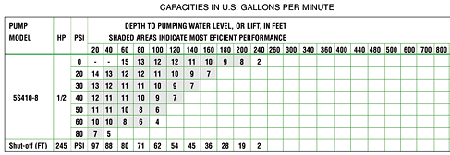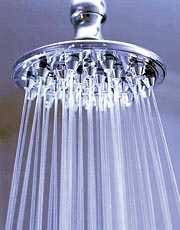This is the third segment in a series on pump selection and pump performance curves and charts. In our last two articles, we discussed factors that should be considered when selecting a ground water pump, when to use a jet pump vs. a submersible, how to convert from feet of head to psi, how to read performance curves, how performance curves are generated and how to estimate the cost of operation of a pump. This month, we will look at performance charts - another way to evaluate the performance characteristics of a ground water pump.

The first two columns show the model number and HP, and the third column lists the delivery pressure in psi. This value is the pressure available to fill the pressure tank and shut off your pressure switch. You should choose a pump that has enough capacity to provide more than enough pressure to shut off the pressure switch and to allow for a drop in the pumping level and/or the eventual deterioration of the pump's performance. If you have a 20/40-pressure switch, choose a pump that gives you 50 psi at the desired flow rate and pumping level.
The row of numbers across the top beginning with 20 and ending with 1,000 is the vertical distance from the pumping level in the well - not the level at which the pump is located but the level of the water in the well when the pump is running - to the level of the pressure tank and pressure switch. In other words, how far the pump has to push the water to get it up to the tank pressure switch. Once you've pressurized the tank, it provides the working pressure to get the water to the fixtures in the house.

The numbers in the boxes on the chart represent the gpm available at the various combinations of pumping level and discharge pressure. For example, this 10-gpm pump can deliver water from more than 200 feet. But if you are pumping into a pressure tank with a 30/50 pressure switch, from a pumping level of 120 feet, you would never develop enough pressure to shut off the pressure switch. Shut-off information is contained in the bottom row of numbers in terms of feet of head at zero flow (245 ft. for this pump) or psi at various pumping levels. You can see that the total shut-off pressure available at a 120-foot pumping level is 54 psi. Even with a brand new pump that performs up to the manufacturer's published curve, you would never build enough pressure to satisfy the pressure switch. Plus, you have not built into your system any reserve for a drop in the water level in the well or in the pump's performance.
This chart also shows at what pressure you can provide a particular flow rate for a given pumping level. Let's say our pumping level is 120 feet. If the system demand were 10 gpm, you would be able to provide 10 gpm continuously at 20 psi with this pump. Once the household demand goes away, all of the flow will go into the pressure tank, decreasing as the pressure tank fills. The pressure will build up to a maximum of 54 psi, according to the chart, which would turn off the 30/50 pressure switch. This would not leave much margin for error, but it would work.

Jet Pump Performance Charts
Performance charts for jet pumps are similar to those for subs but contain additional information having to do with a jet pump's suction lift capability. Figures 2 and 3 show shallow well and deep well performance charts for a 1⁄2-HP convertible jet pump. Notice that the total suction lift for the shallow well configuration will max out at 25 feet because its lifting capability is limited by atmospheric pressure to that height. Please refer to our March 2003 article in this publication for a refresher on how pumps lift water. You can find this article at www.drilleronline.com. Click on “Editorial Archives” and search for “How Centrifugal Pumps Lift Water”.
In the deep well configuration, the jet assembly is down in the well and pushes the water up to the surface, so it is not limited by atmospheric pressure. Figure 3 shows that this same 1⁄2-HP pump can lift (actually push) from 60 feet and still provide 5 gpm at 30 psi. The one additional column on the right side of the deep well chart shows minimum operating pressure for the injector. This is the amount of pressure required to operate the injector measured at the pump. If you are using a pressure switch and it is set above this number, you are covered. If you are pumping into an open tank, you will have to throttle the discharge to provide the necessary minimum amount of backpressure.

In summary, the ability to properly use performance curves and charts is critical to selecting the right pump for the job, in terms of both getting the job done right and also in doing it efficiently. With a little practice, the process of selecting pumps will become second nature.
Next month, we will attempt to unravel the mysteries of NPSH - net positive suction head. 'Til then … . ND

Report Abusive Comment